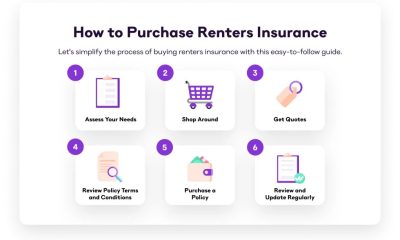Insurance
The Types Of Insurance Policies & Coverage You Need

We can’t avoid the unexpected, but we may occasionally protect ourselves and our family from the worst of the financial consequences. The correct type and amount of insurance depends on your individual circumstances, such as children, age, lifestyle, and employment advantages.
To help you sort through your options, here are the main types of insurance policies:
1. Life Insurance
The two basic types of life insurance are traditional whole life and term life
- Whole life: We can’t avoid the unexpected, but we may occasionally protect ourselves and our family from the worst of the financial consequences. The correct type and amount of insurance depends on your individual circumstances, such as children, age, lifestyle, and employment advantages.
- Term life: Covers you for a fixed period of time, such as 10, 20, or 30 years, and your premiums remain consistent. A term policy, which is often the least expensive sort of life insurance, can be used to cover the years that a mortgage loan is outstanding or your children’s college years.
If your family relies on your income, life insurance is crucial. Industry analysts recommend a 10-times-annual-income policy. Consider funeral costs while calculating life insurance. Then calculate your family’s daily costs. Mortgage payments, loans, credit card debt, taxes, child care, and college fees are examples.
A 2023 BLS report found that 48.9% of married-couple families had both spouses working and earning in 2022. Up from 46.8% in 2021. They may suffer financially if a wage earner dies. BLS. “Employment Characteristics of Families Summary.
2. Health Insurance
Health insurance can be acquired through your workplace, the federal health insurance marketplace, or privately by contacting health insurance firms or agents.
In 2021, 9.2% of Americans were uninsured, according to the CDC’s National Center for Health Statistics. Over 60% of individuals had coverage through their job or commercial insurance marketplace, while the rest received government-subsidized programs like Medicare, Medicaid, veterans’ benefits, and the Affordable Care Act’s federal marketplace.
A small policy is better than none if you’re on a restricted budget. Medicaid is available to 80 million low-income Americans. If your salary is moderate but not enough for insurance, the Affordable Care Act may subsidize your coverage.
Using your employer’s insurance coverage is usually the best and cheapest option for salaried workers. The Kaiser Family Foundation found that in 2022, the average annual premium cost to an employee in an employer-sponsored healthcare program was $22,463 for a family plan. The Kaiser Family Foundation “2022 Employer Health Benefits Survey.
3. Long-Term Disability Coverage
Without job, long-term disability insurance helps. One in four new workers will become incapacitated before retirement, according to the Social Security Administration. The SSA. “The Faces and Facts of Disability/Facts.”
While health insurance covers hospitalization and medical fees, you often have to pay for everything your paycheck covered. Employee benefits often include short- and long-term disability insurance. The greatest way to get affordable disability insurance is this. If your workplace doesn’t offer long-term insurance, consider these factors before buying your own:
- A policy that guarantees income replacement is optimal. Many policies pay 40% to 70% of your income.
The cost of disability insurance is based on many factors, including age, lifestyle, and health. The average cost is 1% to 3% of your annual salary. - Before you buy, read the fine print. Many plans require a three-month waiting period before the coverage kicks in, provide a maximum of three years’ worth of coverage, and have significant policy exclusions.
The National Highway Traffic Safety Administration reported 31,785 traffic fatalities in the first nine months of 2022, despite years of auto safety advances. Drivers must obtain auto insurance in most states and are financially liable for any damage or injuries they cause. Car insurance options:
- Liability coverage: Pays for property damage and injuries you cause to others if you’re at fault for an accident and also covers litigation costs and judgments or settlements if you’re sued because of a car accident.
- Comprehensive and collision coverage: Collision insurance pays to repair or replace your car after an accident, regardless of fault. Comprehensive insurance covers theft and damage to your car due to floods, hail, fire, vandalism, falling objects, and animal strikes. When you finance your car or lease a car, this type of insurance is mandatory.
- Uninsured/underinsured motorist (UM) coverage: If an uninsured or underinsured driver strikes your vehicle, this coverage pays for you and your passenger’s medical expenses and may also account for lost income or compensate for pain and suffering.
- Personal injury protection (PIP): PIP insurance helps reimburse you and your passengers for costs such as rehabilitation and lost wages.
- Medical payment coverage: MedPay coverage helps pay for medical expenses, typically between $1,000 and $5,000 for you and your passengers if you’re injured in an accident.
As with all insurance, your situation determines cost. Compare various rate quotes and coverage, and check occasionally to see if your age, driving record, or location qualify you for a reduced premium.
5. Home Insurance
Homeowners insurance is not required by state, unlike auto insurance. If you financed your house, your lender will likely require coverage to safeguard their interest. Thus, if your home is damaged or destroyed, you can rebuild and keep your mortgage.
If something damages or destroys your home without home insurance, you’re responsible for repairs or replacement. Buying home insurance is smart.
Home insurance policies wrap up several types of coverage, including:
- Dwelling coverage. From your roof to your floors, dwelling coverage protects the structure of your house from unexpected events like fire, wind, theft or vandalism. This type of coverage also pays to repair or replace structures attached to your property, such as a garage or deck. Your dwelling coverage amount should equal the cost of rebuilding your house.
- Personal property coverage. This type of coverage protects your personal belongings, such as furniture, appliances and clothing. Problems covered include theft, fire and explosions. Coverage for personal property is usually set at an amount between 50% and 70% of
- your dwelling coverage. You can usually buy more coverage if you need more.
Other structures on the property. Structures on your property like a tool shed or fence are covered under this type of coverage. - Liability coverage. Liability insurance pays for injuries or property damage you accidentally cause to others. Additionally, liability home insurance covers your attorney fees if someone sues you. So, if a visitor falls on your front steps, liability coverage can pay for their
- medical bills and your lawyer fees. The amount of your liability insurance should equal your net worth or what could be taken from you in a lawsuit.
- Additional living expenses. If you are temporarily displaced from your home because it’s been damaged by a problem covered by your policy, additional living expenses coverage pays extra costs such as for meals and lodging.
Remember that a standard home insurance policy doesn’t cover damage from floods or earthquakes, but separate insurance is available for these problems.
6. Renters Insurance
Non-homeowners require insurance too. Renters insurance replaces stolen or damaged equipment, furniture, and clothing. Issues include fire, tornadoes, explosions, and more. If your rental burns down, you must replace everything without coverage. Your landlord’s insurance covers rental structure damage but not tenant property. Some landlords request evidence of coverage to rent.
Renters insurance includes:
- Personal property coverage. This coverage reimburses you if your stuff (furniture, clothing, dishes, etc.) is stolen or damaged by an issue like a fire.
- Liability coverage. If you’re liable for someone else’s injuries or property damages, this coverage can pay for the cost involved. For example, if someone falls in your apartment due to your negligence, liability insurance can pay for their medical bills.
- Additional living expenses coverage. If your rental is damaged or destroyed by a problem covered by the policy, making it uninhabitable, this coverage will pay for your extra costs while you can’t live at home.
7. Umbrella Insurance
Liability coverage on auto, house, and renters insurance protects you and your family from litigation. But all policies have liability limits. Having large assets may make your homeowners, renters, or auto liability insurance insufficient if you lose an expensive lawsuit.
In the event of an unforeseen liability, umbrella insurance can help. Example: Someone trips on your sidewalk and injures their back, suing you for $500,000 in medical bills. You must pay the remaining $200,000 if your home insurance coverage limit is $300,000. The umbrella insurance would pay this extra expense.
8. Long-Term Care Insurance
The HHS expects that 70% of 65-year-olds will need long-term care. Most elders will need in-home or nursing care assistance. Long-term care is costly. Genworth, a life and long-term care insurer, estimates private nursing home rooms cost $9,000 a month.
Long-term care insurance includes in-home, adult day, and nursing home care. Long-term care insurance is greatest in your 50s or 60s. Insurance is inexpensive in this age bracket. LTC insurance costs climb with age.
Research this product before buying. Consumers were surprised by large rate spikes that made insurance unaffordable after purchasing it. The CRS insures long-term care. Life insurance riders and bundles can include long-term care (LTC) coverage.
9. Permanent life insurance
Life long permanent life insurance is available. In addition to the death benefit, permanent life insurance has cash value. If cash value rises, you can borrow or withdraw. If you cancel, you can get the cash value (less the surrender charge).
If you want to develop cash value for retirement or give a death benefit for a long-term dependent, consider permanent life insurance. Permanent life insurance costs more than term. Whole, universal, variable, and burial life insurance are permanent.
Source: Investopedia and Forbes










